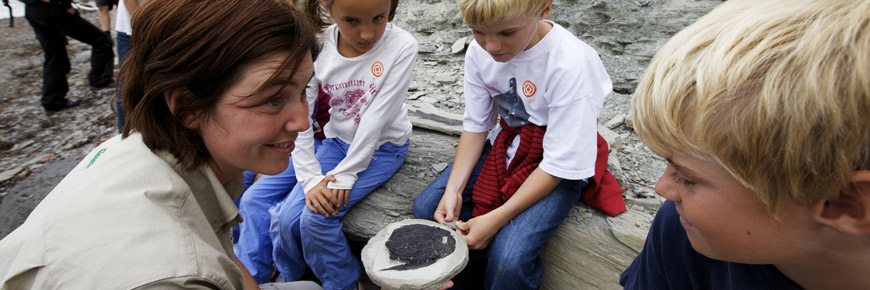
Miguasha National Park
Québec
Date of Inscription: 1999
Some 370 million years ago, what is today the austere coast of the Gaspé Peninsula was a tropical estuary. The craggy peaks of the Appalachians lined the horizon. Primitive trees, scorpions and spiders covered the land. In the warm tidal waters, an astonishing variety of fish thrived. Some were spiny, some armour-plated. Others had lungs and pairs of lobe-like fins that enabled them to crawl across mud flats- and enact one of the major steps in evolution, when fish evolved into four-limbed animals.
Justification of outstanding universal value
Miguasha National Park was designated as a World Heritage site by UNESCO’s World Heritage Committee under the following criterion:
Criterion (viii): In its representation of vertebrate life, Miguasha is the most outstanding fossil site in the world for illustrating the Devonian as the “Age of Fishes”. The area is of paramount importance in having the greatest number and best preserved fossil specimens found anywhere in the world of the lobe-finned fishes that gave rise to the first four-legged, air-breathing terrestrial vertebrates - the tetrapodes.
Full description
We know this today because a two-million-year snapshot of life at the time is preserved in the remarkably rich fossil beds of the Escuminac Formation, which is exposed in a seaside cliff at Miguasha, on the south shore of the Gaspé facing Baie des Chaleurs. There are some 60 such Devonian period fossil sites around the world. But none matches Miguasha in abundance of specimens, quality of fossil preservation and representation of evolutionary events for vertebrates. It is the only Devonian site on the World Heritage List.
There is sufficient biodiversity at Miguasha - scores of species of vertebrates, invertebrates, plants, algae and micro-organisms - for scientists to have constructed an almost complete picture of Devonian life. But it is the 21 species of fish fossils that made Miguasha famous, none more so than Eusthenopteron foordi, the “Prince of Miguasha,” whose limb-like fins and two-way gills-and-lungs respiratory system gave rise to the modern conception of evolution from fish to four-limbed, land-dwelling vertebrates, or tetrapods.
The Miguasha fossil beds were discovered in 1842. Starting in the 1880s, thousands of fossil specimens were collected and shipped to museums and universities around the world, helping to confirm the site’s scientific importance.
More Information
Province of Quebec:
World Heritage Centre:
Related links
- Anticosti, Quebec
- Tr’ondëk-Klondike, Yukon
- Writing-on-Stone / Áísínai’pi
- L’Anse aux Meadows National Historic Site
- Nahanni National Park Reserve
- Dinosaur Provincial Park
- Kluane / Wrangell-St.Elias / Glacier Bay /...
- Head-Smashed-In Buffalo Jump
- SG̱ang Gwaay
- Wood Buffalo National Park
- Canadian Rocky Mountain Parks
- Historic District of Old Québec
- Gros Morne National Park
- Old Town Lunenburg
- Waterton-Glacier International Peace Park
- Rideau Canal
- Joggins Fossil Cliffs
- Landscape of Grand Pré
- Red Bay Basque Whaling Station
- Mistaken Point
- Pimachiowin Aki
- Date modified :